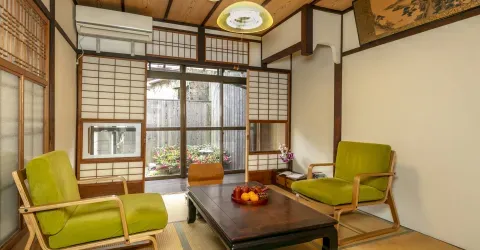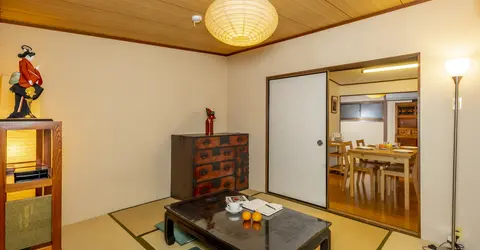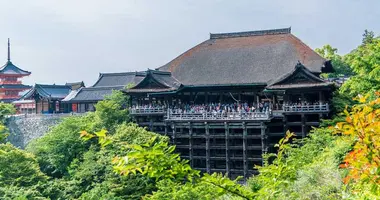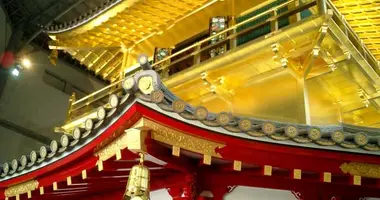Kyoto Autumn Leaves Viewing Spots
- Published on : 12/11/2014
- by : Japan Experience
- Youtube
Kyoto fall colors: see a listing of the best places to see the autumn leaves (momiji) in Kyoto including Arashiyama, Tofukuji and Mt Takao.
Fall Leaves in Kyoto 紅葉
 Fall Leaves in Kyoto 紅葉, Arashiyama
Fall Leaves in Kyoto 紅葉, Arashiyama
The best and most popular season to visit Kyoto is in the fall for its autumn leaves. Hotels, ryokan and pensions in Kyoto tend to book out as domestic and international tourists flock to the city to enjoy the celebrated changing of the colors of the leaves known as kouyou (紅葉) or momiji (red maples).
Kyoto's hundreds of famous temples and shrines and the hills that surround the city on three sides are awash with the colors of autumn, the scarlets and deep reds of maples and the pale yellows of ginkgo.
The weather in Kyoto through November, when the leaves begin to turn, is usually dry and bright, though rainy days are almost guaranteed as well. The evenings are cool and there may be a chill in the air. The fall is when the food in Kyoto is said to be at its best and the restaurants, cafes and bars of the town are as packed as its temples and shrines.
Due to the rise in global temperatures the leaves begin to turn later, nearer to the end, rather than the middle of October. The red momiji in Kyoto are usually at their peak in mid-November and continue until mid- to late December.
Below is a list of some of the best places to see the autumn colors in Kyoto.
 Autumn leaves in Arashiyama, Kyoto, Japan
Autumn leaves in Arashiyama, Kyoto, Japan
 Sennyuji Temple in south west Kyoto with pagoda and early fall colors.
Sennyuji Temple in south west Kyoto with pagoda and early fall colors.
Kyoto
Kyoto is the jewel in the crown for refined appreciation of the autumn leaves in its immaculately kept temple gardens, parks and shrines.
Arashiyama
Arashiyama is the pièce de résistance of Kyoto kouyou. On a sunny day the light glows through the small-leafed momiji maples on the hills over the river and in the area's many temples and shrines. As well as the most-visited Tenryuji Temple (see below) visitors should also head for Nonomiya Shrine, Okochi Sanso Villa, Jojakkoji, Hogon-in and Kogenji.
Chionin
Chionin Temple, south of Okazaki, has illuminations from 5.30 pm to 9 pm (admission fee) and this large Jodo sect temple has massive grounds with 21 sub-temples.
Eikando
Eikando in the ancient capital's southern Higashiyama mountains close to Nanzenji is justly singled out for its maple trees and fall foliage.
Enkoji Temple
Enkoji is a short walk from either Manshuin or Shisendo in Higashiyama and rewards with a lovely, though small garden famed for its maples.
Kitano Tenmangu
Kitano Tenmangu may be more famous for its plum blossoms in February, but it has some wonderful maples to the west of its main hall along the Kamiya River and the Odoi (御土居), an earthwork and system of moats built by the warlord Toyotomi Hideyoshi around Kyoto in 1591. A special entrance charge enables visitors to stroll this lovely walk which includes a red arched bridge and stone monument engraved with the three kanji characters for Odoi. The area is illuminated and stays open until 8 pm from the middle of November to the end of the first week of December.
Kiyomizudera
Kiyomizudera Temple draws the crowds year round but especially in the fall when visitors gaze down on a sea of red from the large veranda attached to the Main Hall.
Kodaiji
Kodaiji, close to Nene-no-Michi, in the Gion area of Kyoto is another popular spot for viewing the autumn leaves at night, with the leaves reflected in the temple's pond. Evening illumination is from sunset to 9.30 pm (Admission fee).
 Tenryuji Temple in Kyoto is famous for the beauty of its autumn maple leaves.
Tenryuji Temple in Kyoto is famous for the beauty of its autumn maple leaves.
 Shugakuin Rikyu Imperial Villa (Shugakuin Detached Palace), Kyoto
Shugakuin Rikyu Imperial Villa (Shugakuin Detached Palace), Kyoto
Nanzenji
Nanzenji in the southern Higashiyama area of Kyoto is well worth visiting during November when the temple grounds are illuminated in the last two weeks of November from 5.30 pm-9 pm. Admission fee 500 yen.
Rokuoin
Rokuoin Temple is close to Arashiyama but gets far fewer visitors. The stone pavement from the main entrance gate to the temple is lined on either side by a sea of red maples.
Sagano
Located at the base of hills, just north of Arashiyama (which, strictly speaking, occupies only the area south of the river), Sagano has a number of temples worth seeing for their fall colors. These include Gioji, a retreat for the former lovers of a Heian Period warrior, Taira no Kiyomori (1118-81), Nison-in, Saga Shakado and Adashino Nembutsuji. Hiking nearby Mt. Atago to Atago Shrine and Tsukinowadera is worthwhile for spectacular views. Daikakuji Temple and Osawa Pond to the north is another place on the momiji march.
Sanzenin
Sanzen-in Temple in the Ohara district north east of Kyoto on the road to Shiga is well-known for its delicate, early autumn leaves.
Sekizanzenin
A personal favorite close to Shugakuin Rikyu (also known for its leaves), the sloped entrance path from the main gate of Sekizanzenin is a delight in the fall. The hills of northern Higashiyama and the slopes of Mt. Hiei are both visible from this area of Shugakuin.
Shinnyodo
Shinnyodo, close to and west of Ginkakuji and Philosopher's Walk, is something of a hidden treasure as tour buses cannot climb the narrow, twisting lanes to the temple, which combines an atmospheric pagoda with lovely autumn leaves. Walk west from here over Yoshidayama to the main campus of Kyoto University at Hyakumanben.
Shorenin
Shorenin Temple is a Tendai sect temple directly south of Heian Shrine and known for the beauty of its spacious gardens. The gardens are lit by blue LED lighting from the end of October to the end of December.
Takao
Takao is an elevated, sparsely-populated area north of Kyoto, somewhat off-the-beaten track but well worth the long bus ride for the solitude and spectacular views of the surrounding hills and the Kiyotaki River valley. Jingoji Temple, with its associations with Kukai, has some wonderful fall colors as does the ancient temple of Kozanji.
Tenryuji
Tenryuji is Arashiyama's most famous temple and known for the vivid reds of its momiji maple trees. Try to come mid-week to avoid the crowds.
Tofukuji
Tofukuji Temple also allows visitors to gaze down on the maples in the ravine below from the Tsuten-kyo Bridge. Nearby Sennyuji Temple is less busy and the large, hilly temple grounds have some beautiful colors in season.
Yoshiminedera
Yoshiminedera Temple and Jurinji Temple are a bit of a trek to reach in the south western suburbs of Kyoto from Higashi Muko Station on the Hankyu Line. The hike is rewarded by a 600-year-old white pine in Yoshiminedera and wonderful views over the hills below, especially in the fall.
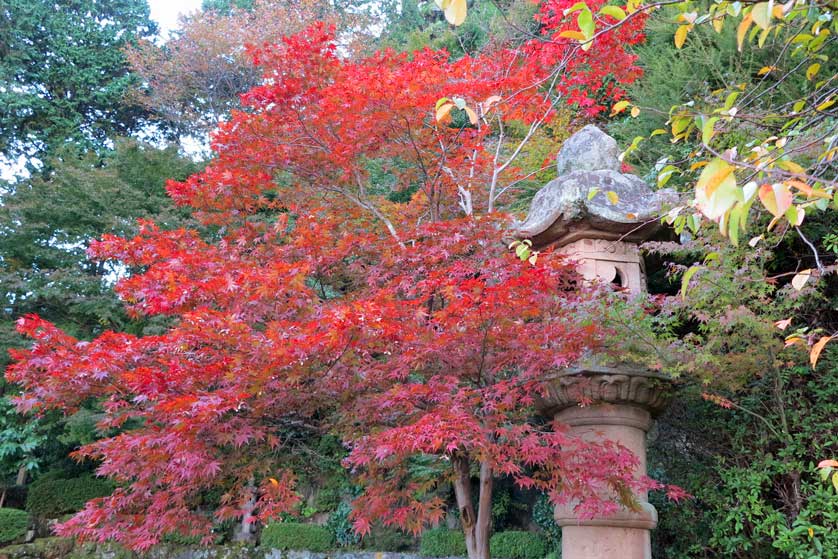 Yoshiminedera Temple in Kyoto is known for its beautiful fall colors
Yoshiminedera Temple in Kyoto is known for its beautiful fall colors
Related Japan Seasonal Links
List of Parks and Gardens in Japan
Japan's Best Fall Colors Viewing Spots
Tokyo Best Fall Colors Spots
Tokyo Cherry Blossom Spots
Kyoto Cherry Blossom Spots
Two Days in Kyoto Itinerary
